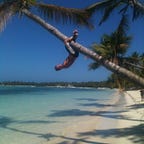FLYING THE ILS
The ILS is the most commonly used IAP (instrument approach procedure) among pilots. We’ve already covered the basics of the ILS so let’s go over how to fly it.
No matter what approach we are doing, we always want to get the latest weather, or ATIS information, in advance. This way, we learn what runways and approaches are currently in use.
We are now ready to setup our approach. Load it into the FMS (Flight Management System), get the corresponding approach plate, select the relevant COM/NAV frequencies, minimas, course, heading, altitude, etc..
Now it’s time for the approach briefing. The aim of briefing the approach prior to flying it is to help pilots understand the desired sequence of events and actions, as well as the condition of the aircraft and any special threats, hazards or circumstances involved in the planned flight sequence.
We call ready, get our approach clearance, complete the approach checklist and then we are ready to fly the approach.
First, we align our airplane with the runway using the localizer for horizontal guidance. Depending on the approach, this is done by vectors from ATC or with a procedure turn.
We configure our aircraft for landing before the FAP (Final Approach Fix) and intercept the glideslope from below. Procedures for configuration may vary depending on aircraft type and operator.
As we start our final descent at the FAP, we set the missed approach altitude. If we deviate off course, the localizer and glideslope needles will deflect. Whether the deflection is left, right, up, or down, remember to “FLY TO THE NEEDLE”. The needle displays where you should fly to!
As we close in on the runway both localizer and glideslope signals become more sensitive. This is so because the course width decreases as we get closer. Use small corrections to avoid ‘chasing the needle’. We want to keep a relatively constant pitch attitude for the comfort of our passengers.
Pro tip: CHANGE — CHECK — HOLD — ADJUST — TRIM
When 1,000 ft. above elevation the callout is “One to go!”
As we approach minimas we will decide if we can continue or go around based on our visual contact with the runway, or approach lighting. The callout will be “100 ft to minimas!” followed by “Visual contact, decision CONTINUE!”, or “Not visual, decision GO AROUND!”.
